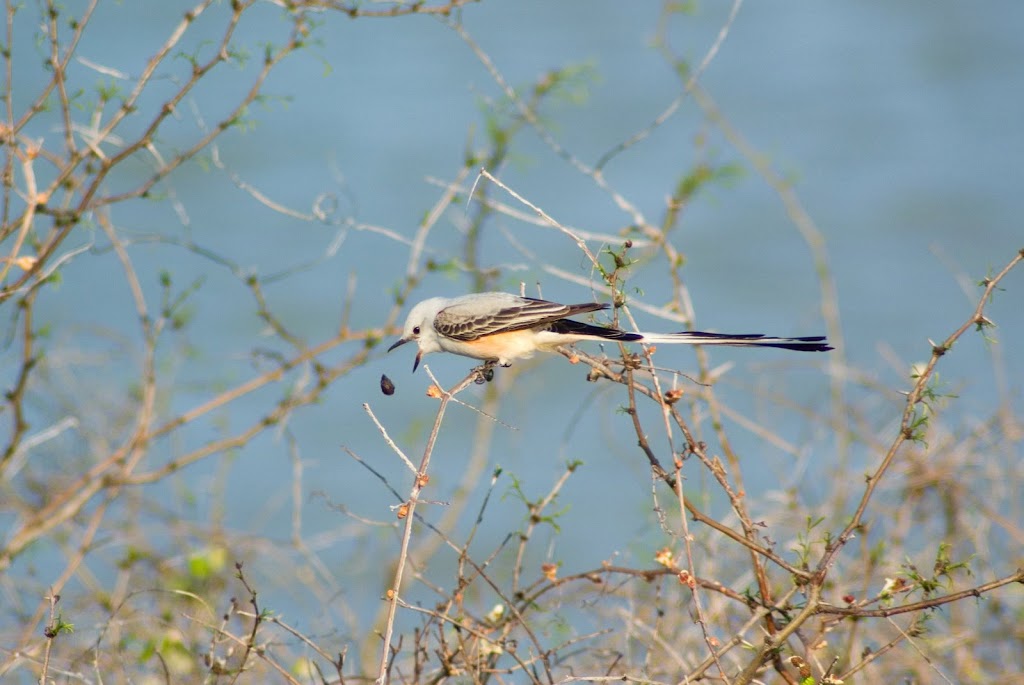So, if you can reach 486mm (effective) with the FZ35 on its own, do you really need the 1.7x teleconverter? After all, you can always just shoot at full zoom and crop, to make the subject appear bigger in the frame.
Well, the short answer is that the teleconverter is indeed useful.
Here is a photo of a car across the street. This was taken at full zoom extension (486mm equivalent) and cropped. What you are seeing here is actually a screen shot from Adobe Lightroom 3.
Now here is essentially the same shot, taken with the Panasonic DMW-LT55 1.7x teleconverter attached.
As you can see, the field of view is about the same in the two photos, that is, the car is about the same size in each photo. And the two images look just about identical in other ways, at least at this size. So are they in fact identical? Is the one taken without the teleconverter as good as the one take with the teleconverter?
No, it's not.
The one taken with the teleconverter actually has more pixels, more data. This means several good things. It will be possible to print the second shot somewhat larger than the first. The second shot will be more amenable to certain post-processing maneuvers, such as noise reduction and sharpening, because there is more data to work with.
Here's an enlargement of the license plate from the first shot (the one taken without the teleconverter). The enlargement ratio here is 3:1.
And here is an enlargement from the second photo (the one taken with the help of the teleconverter). The enlargement ratio here is only 2:1. In other words, I didn't have to work the pixels as hard this time to get the same size on screen.
The difference doesn't seem dramatic at first glance, but look again. Look at the Nissan badge above the plate, or the State of Texas symbol in the middle of the plate, or the word "MAXIMA" at the bottom. In the second image, everything is a little sharper, a little smoother and less pixelated.
*
Here they are again, a little smaller. I'm simulating the effect of printing here. You should be able to see that the second image is sharper and simply "better" than the first one. If you can't see the difference, well, you might be running into the limitations imposed by your computer's display.
The bottom line here is, the 1.7x teleconverter is actually useful. Say I have the good fortune not only to see a wolf in Yellowstone but actually to be able to set up my tripod and take a photo of one. From what I've read, it's almost certain that the wolf is going to be a long way in the distance. I can take the shot with or without the teleconverter. But if I use the teleconverter, I'll collect more data. The image of the wolf will be comprised of more pixels, which means the wolf will be higher resolution. And that's good.
A final point. There's a practical limit to the advantage of the teleconverter, and I'm working very close to that limit. The limit is set by two things: the quality (acuity or sharpness) of the lens; and the effective focal length at which you are working when the teleconverter is attached.
The quality of the lens that channels light to the camera's sensor determines how efficiently and effectively the available pixels are used. The number of pixels captured isn't the only thing that matters, in fact, it's not even the most important thing. A really good lens on a 10 megapixel camera will produce better photos than a mediocre lens on a 14 megapixel camera. Returning to the FZ35 and the teleconverter, the FZ35's built-in Leica lens is rather good, and the Panasonic teleconverter is not bad. But at full zoom extension, the FZ35 plus teleconverter seems to have reached its maximum resolving power, that is, more pixels in the sensor wouldn't matter because the lens is already starting to lose detail. A lens is an analog device, of course, it doesn't have pixels. But you can't just keep giving the lens more and more pixels and expect the lens to record finer and finer detail.
The other practical limit here is imposed by the focal length. With the 1.7x teleconverter attached, the FZ35, at full zoom extension, is shooting at a focal length equivalent to 826mm. Most serious photographers never own a lens with an effective focal length greater than 500mm, and many never even reach that. Now, when you are shooting at 500mm, 600mm, 800mm, even the tiniest vibration or instability in the camera can affect the sharpness of the image that is captured. The photos above were not taken with the camera on a tripod; I simply used a monopod. If I do use the teleconverter in Yellowstone, I will have the camera on a tripod, and I will use a 2 second shutter delay so I can get my hands off the camera before the picture is actually taken. At this extreme focal length, the merest touch can wreck a photo.
Nevertheless, while the teleconverter is pushing the FZ35 to its extreme limits, it's not exceeding those limits and if you really need extra telephoto reach, it's better to have the 1.7x lens than to do without and simply crop. Q.E.D.
![William Porter Photography [2009-10]](https://blogger.googleusercontent.com/img/b/R29vZ2xl/AVvXsEivarWsIzJ4UBGkZm5Bhjfzd86M8FVCsnN6XYKbLreeu9ClcuVDhxQ01Et3CzACm0EEmSb8ysiGiONwchtch3c20CgUQJTV0GhZh5C0Bd-1DfUo29rk-UeOlREIxl8OTd1T3kNrMWHre3EV/s1600/GOOGLE+320x132.png)

























